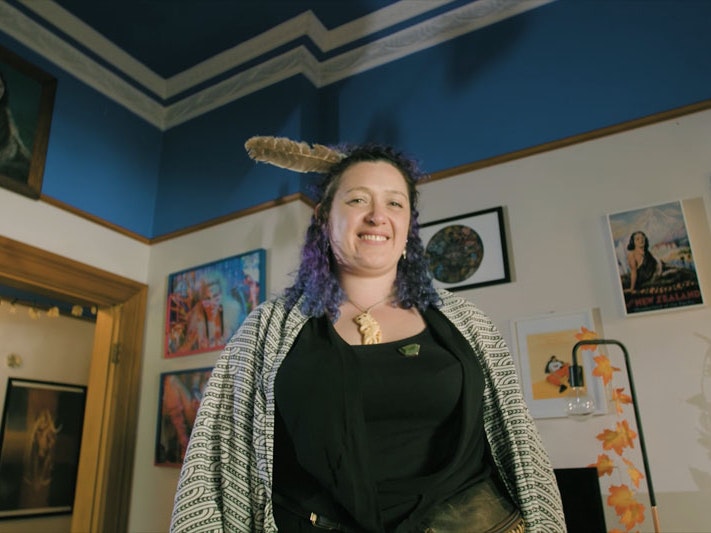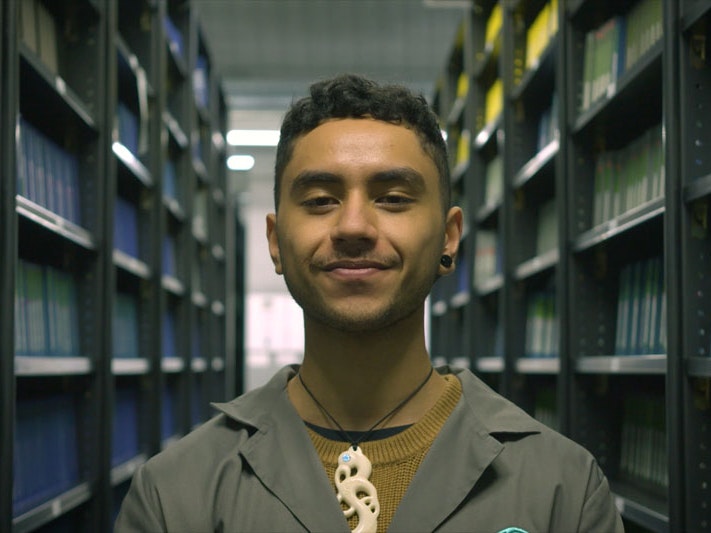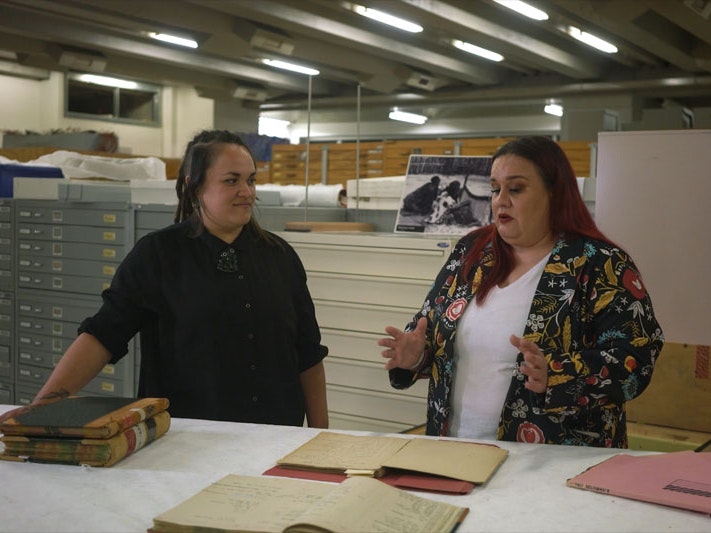Khali meets Isaac Te Awa, a curator in the taonga Māori collections. Together they check out some early taonga Māori in the collections and talk about how they got to be here in places like Te Papa. Spoiler alert: It usually wasn’t a good story.
Both Isaac and Khali reflect on their relationships to these taonga, and their hopes for how we as te iwi Māori can connect with them. This first chapter of our story is about understanding the basics, about origin stories. It’s also a chance to reflect on how Māori within institutions are slowly guiding taonga back to their people.
Mauri ora!
– Director Kahu Kutia
This video is available with subtitles in English (with te reo Māori), and te reo Māori.
Transcript
Khali Meari: Me pewhea tātou e mohio pū ki a tātou ano.
Mā te whakataki i ngā whakapapa.
Mā te wānanga mā te a roa tū ki ngā kōrero.
Ki Ngā Taonga Tuku Iho.
Ao tātou tīpuna.
[Khali recites pepeha]
Tihei mauri ora!
Kia ora, my name is Khali.
In my daily life, I am a storyteller. I work to normalise our kōrero pūrakau in your everyday environment.
When I think of the collection of taonga that are held across Aotearoa – but also across the world – in these boxes and cases and in specialised rooms, I feel a sense of grief.
Ko tāku ko te meanui he whakamahana i ēnei taonga, i ēnei kōrero tuku iho me ngā waihotanga ngā tīpuna.
We are a new generation, guided by those who came before us.
Te aho tapu, once woven by our tīpuna, are now in our hands, and in the hands of collections, putānoa i te ao.
Our mātauranga, our histories, our stories, and our taonga guide us to understand how to walk backwards into the future.
First things first e te whānau, we need to understand the basics. How did our taonga become a part of these collections.
I’m here at Te Papa Tongarewa and I’m here to meet Isaac Te Awa, a Māori curator. I want to know from him how many taonga are in the collection, where they came from, and who collected them. Let’s go!
Isaac Te Awa: Ko Isaac Te Awa tōku ingoa. Ko aū he uri o Kāti Māmoe Kāi Tahu, Waitaha o hoki ki te taha toku Matua. Nō Ngāpuhi ki Whangaroa ahau. Ko au he kaitiaki o te mātauranga Māori.
So, I am a Curator Mātauranga Māori here at Te Papa. I also am a practitioner of raranga. So I learnt tāniko and whatu from my koro and that is the basis of my practice and my mahi here at Te Papa.
So, there is a lot of taonga here. Ah, but to really go into how the got here you have to go into the history of collecting – and primarily for Māori and Pacific people that was Pākeha, middle-aged white men who were ethnographers, bibliophiles and researchers of the time period.
So, it’s not natural for Māori to want to store all their taonga in one place.
They were really interested in the narratives for how they see Māori, the noble savage, uh, the warrior, ah, the dusky maiden, and what that means is in our collections we see a lot of taonga that are collected in terms of mau rākau, weapons, we see a lot of beautiful whakairo, we see lots of beautifully carved pieces of toki and pounamu. What we don’t see is anything to do with kids’ toys or wāhine.
So what that means is we are left with a collection that is already biased towards how Pākeha perceived us. So, to try tell Māori stories out of those taonga is the challenge.
Our people aren’t static. We always moved, we were always dynamic, and we always evolved to our environment and our practices.
I believe that our taonga carry the living mauri of our thoughts.
So, to bring in practitioners, whānau, hapu, and iwi who can use taonga to create their own artforms, to share their own kōrero and stories, it’s about bringing people inside the building and connecting with things that they’ve been so detached from.
I think that’s what I love most about my job.
Ah, recently, we had a hue that someone came in and viewed and they recognised it as something that their koro had made, but they were also able to tell us that there were six of them that were made.
So we had one, but there’s five more out there and now one’s in Auckland. But it tells a complete kōrero and a complete whakapapa.
We have another practitioner who’s currently working with a hīnaki to revive that practice in Whanganui where they’ve forgotten how to make hīnaki out of the materials found in te taiao.
So those are the beautiful stories and the real ’why’ that collections have for our people.
Well e hoa, we’ve talked a lot about taonga and access and I think the best way for us to actually show you how that works is to actually go and see some taonga. Should we go?
Khali: Yeaaaah.
Isaac: We’re gonna go inside Whare Pora and have a look at some taonga. I’ll kick us off with some karakia and then we’ll go from there.
Cool, hara mai.
[Karakia]
Hui e! Taiki e!
Tēnā koe.
Khali: Wow.
Isaac: Alright, well, welcome to Whare Pora, e hoa.
Khali: Kia ora.
Isaac: So on the table in front of us we have a variety of taonga, a selection of some of the few from Te Papa.
All of these taonga are unprovenanced, which is museum talk for that we don’t know where they are from. But, if we look at taonga carefully, they can give us clues.
So this one here, is off a Cook journey. Even though we don’t know where it’s from, what we can tell from the whakairo and the elongated upoko, is that it is likely from Tai Tokerau, Northland.
Even though we don’t know the full story of a lot of these taonga they carry their own whakapapa.
One of the things that irritates me is that a lot of the taonga from Cook journeys were given to Tupaia, so if Tupaia is the common connection between a lot of these taonga, why do we still refer to them as ‘The Cook Collection’ or ‘The Banks Collection’?
Tupaia is the whakapapa or the hononga back to Māori. So it returns its own mana to these taonga.
This is the newest taonga on the table. Houhere is the inner bark of the lace bark tree, and it’s not commonly used in the North to make any taonga; it’s more common in the South.
What I love about this poi is that if you look really closely, um, what can you see on the inside?
Khali: Hmm, like, paper?
Isaac: So, it’s newspaper.
So even though we don’t know where this poi is from, the time, the date, and the region it’s from is wrapped up inside it. We just don’t have the technology to get it without damaging the taonga.
And so whānau must come in here with you... Can you tell me about how they react or some of their responses?
Ah, so I think the first time people come in and see a taonga is... it’s overwhelming because it’s just been so long since their people have been able to have a connection with taonga that to see so many of them in front of them, it’s something that I’ll never forget.
Ah, but being in the position to actually guide people through those journeys into their own taonga and their own whakapapa and their own stories, ah, kinda reconnects them to [te taha o Māori].
We’ve been so separated from whakapapa toi taonga that we’ve forgotten how to make a lot of these.
So at the moment, these taonga, their lives are being artificially extended by being in the museum, are also providing an invaluable resource to teach our people.
So, taonga like these are helping to rebuild us culturally as a people.
Khali: Yeah, when I look at these taonga and I think about the future. I really want for my mokopuna to be able to come to a place like this and feel as though he whare wānanga tēnei, that there is space for them to be here with their tipuna and with their taonga and that they can openly be in relationship with our taonga.
Isaac: I have to remind myself that 30 years ago our people didn’t have any kaimahi or anyone working in museums to speak to them.
So it’s a long process about providing avenues for our people to come in, for avenues for our people to visit, but more importantly is by having kaimahi and Māori in institutions like this, is that whatever the future for these taonga looks like whether they return to their people, whether practitioners can come
in and use them, whether they can rebirth these taonga and their mauri as new taonga, is that that’s guided by Māori – and that can’t happen if we’re not here to have these kōrero and to have these discussions.
As institutions move more towards accountability it’s a discussion that we’re gonna have to keep bringing up, and keep bringing up, and keep bringing up, because we can’t let them forget that our taonga are here, or that they are intrinsically tied to our identity. And as we move to the future I want to see these taonga used to teach. I want to see them used to rebirth, I want to see them inspire, and I want to see them out in the community again. That’s the goal. That’s part of what mana motuhake looks for Māori. Is that we have the power to make those decisions. And I think it’s something that we’re moving towards.
Khali: Mhm.
It’s painful to reflect on the impact our colonial histories have had on these taonga.
There are many taonga that remain unknown to us by name, because of the ways early missionaries and settlers engaged with our mātauranga.
It’s up to us to relearn these techniques, to reweave these kōrero.
And to be the here that bind our taonga tuku iho to the modern world.
No doubt, there is still a long way to go.
That’s all the kōrero for now.
But come back next time where we’ll be meeting a ringatoi Māori, and learning about how they’re using taonga collections like Te Papa as inspiration in their own contemporary toi practice, reviving mātauranga Māori around jewellery making.


